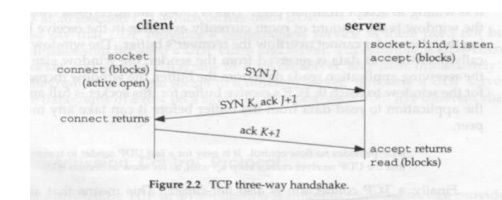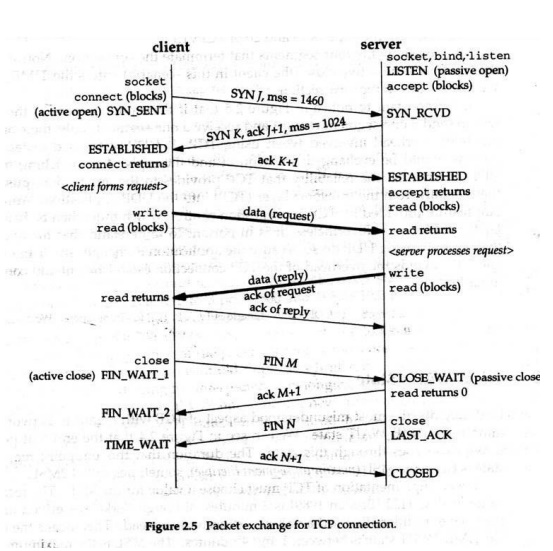Chapter: Network Programming and Management : Elementary TCP Sockets
Overview of TCP / IP protocols
TCP: It is a
connection oriented protocol that provides a reliable, full duplex, bytestream for a user process. It takes
care of details such as acknowledgment,
timeouts, retransmissions etc. TCP can use
either IPv4 or IPv6.
UDP: It is a
connectionless protocol and UDP sockets are example of datagram sockets. In this there
is no guarantee that UDP datagram
ever reach their intended destination.
It can also use IPv4 or IPv6.
ICMP:
Internet Control Message Protocol : It handles errors and control information between router and hosts. These are
generated and processed by TCP /IP networking software itself.
IGMP :
Internet Group Management Protocol: It is used with multicasting which is optional with IPv4.
ARP :
Address Resolution Protocol, maps an
IPv4 address into a hardware address
(such as an Ethernet address).
ARP is normally used on a broadcast networks such as Ethernet, token ring and
FDDI but it is not needed in a point to point network.
RARP :
Reverse ARP: This maps a hardware
address into an IPv4 address. It is sometimes used when a diskless node such as X terminal is booting.
ICMPv6: It combines the functionality of ICMPv4, IGMP and ARP.
BPF :
BSD Packet Filter: This
interface provides the access to the datalink for a process. It is found in Berkley derived kernals.
DLPI: Data Link Provider Interface. This provides access to the datalink and is
normally provided with SVR4.
All the above protocols are defined in the RCF (Request For Comments), which are
supported by their formal specification.
UDP: User
Datagram Protocol ():
•
The
application writes a datagram to a UDP socket which is encapsulated either in
an IPv4 or IPv6 datagram and then sent to destination.
•
UDP
datagram lacks reliability as it requires to build acknowledgements, timeouts,
retransmission etc in the protocol.
•
Datagram
has a length and if its checksum is correct at the receiving end, it is passed
to the receiver.
•
It is a
connectionless service. A client UDP socket can send successive datagram to different
server and similarly, the server UDP socket can receive datagram from different
clients.
TCP: Transmission
Control Protocol:
•
A TCP
provides a connections between clients and servers.
•
A TCP
client establishes a connection with a given server, exchanges data with that
server across the connection and then terminates the connection.
•
• TCP
provides reliability. When data is sent on a TCP socket, it waits for an
acknowledgement for a duration equal or more than the RTT- round trip time. If
after reasonable amount of time, the acknowledgment is not received, TCP will
give up.
•
RTT is
calculated periodically to take care of the congestion in the network.
•
TCP
sequences the data by associating a sequence number with every byte that it
sends. (A byte stream larger than 1024 bytes is split into segments of 1024
bytes and sent to IP. The sequence number of 1-1024 is allotted for first
segment, 1025 - … allotted for second segment and so on.)
•
TCP
provides flow control: Receiver advertises the size of data which it can accept
to its peer. This size of the window varies dynamically. If the buffer at the
receiver is full, the receiver may not accept the data till it is free.
•
TCP
connection is also fully duplex: This means an application can send and receive
data in both direction on a given connection at any time. The TCP must keep
track of state information such as sequence number and window size for each
direction of data flow: sending and receiving.
TCP connection establishment and termination:
To
understand the connect, accept and close
functions and to debug TCP application using neststat we need to follow
the state transition diagram.
The three
way handshake that take place is as follows:
1. The server must be prepared to accept an
incoming connection. This is normally done by calling socket, bind and listen functions and is called passive open.
2. The client issues an active
open by calling connect. This
causes the client TCP to send SYN segment
to tell the server that the client‘s
initial sequence number for the
data that the client will send on
that connection. No data is sent with SYN. ITtcontains an IP header, TCP header and possible TCP options.
3. The
server acknowledges the client‘s SYN and sends its own SYN and the ACK of the
client‘s SYN in a single segment.
4. The client must ACK the server‘s SYN.
As the minimum number of
packets required is 3, it is called three way handshake. This is shown in the
following figure.

J is the
initial sequence number of client and Kis that of Server. ACK number is he
initial sequence number plus 1.
TCP Options:
TCP SYN can
contain TCP options. Common options are: MSS (Maximum Segment Size), Window Scale Option, Time Stamp
Option.
•
MSS Option: With this option the TCP sending SYN announces its maximum segment size, the maximum
amount of data that it is willing to accept in each TCP segment, on this connection. This option is set by
TCP_ MAXSEG socket option.
• Window scale option: The maximum window
that either TCP can advertise to the other TCP is 65535 as the corresponding
field in the TCP header occupies 16 bits. But high speed connections (45
Mbps/sec) or long delay paths require larger window which can be set by left
shifting (scaling) by 0-14 bits giving rise to one gigabyte. This is effected
with SO_RCVBUF socket option.
•
Timestamp option: This option is needed for high speed
connections to prevent possible data
corruption caused by lost packets that then reappears.
Last two options being new, may not be
supported. These are also known as ‗long fat pipe‘ option.
TCP connection Termination:
It takes four
segment to terminate a TCP connection as shown below:
1. One application calls close, and we say that this end
performs the active close. This end‘s TCP sends FIN segment, which means it is
finished sending data.

2. The
other end that receives the FIN
performs the passive close. The received FIN
is acknowledged by TCP. The FIN is passed to the application as an end of
file(after any data that may already be queued for the application to receive)
and the receiver will not receive any further data from the sender.
3. When the received application closes its
socket, the TCP sends FIN.
4. The TCP on the system that receives the
FIN acknowledges the FIN.

The
client in this example announces an MSS(Maximum Segment Size) of 1460 and the
server announces an MSS of 1024. Once the connection is established, the client
forms a request and sends it to the server (fits in one segment). The server
processes the request and sends a reply. The data segments transfer is shown in
bold arrows The four segment shown terminate the connection. As it can be seen
that the end that performs the active close enters the TIME_WAIT state.
Port
Numbers: At any time multiple processes can use either UDP or TCP and both use
16 bit integer port numbers to differentiate these processes. Both TCP and UDP
define a group of well known ports that identity services. Some of these are
port 21 for FTP, TFTP is assigned UDP port 69 etc. Clients use ephemeral ports
that is short lived ports. These port numbers are manually assigned by TCP or
UDP to the client. The port numbers are divided into three categories
• Well
known ports : 0 – 1023 These port numbers are controlled and assigned by the
IANA. When possible same port number is assigned for both TCP and UDP as in the
case of web server.
• The Registered Ports: 1024 – 49151 These are
not controlled by IANA bit it registers and list the uses of these ports as a
convenience to the community
•
Dynamic private ports : 49152 – 65535 These are what we call as
ephemeral ports.
Socket Pair: The
two values that identify each endpoint, an IP address and a port number, are
called a socket. The socket pair for
a TCP connection is the 4 tuple that defined the two end points of the
connection: the local IP address, local TCP port, foreign IP address, and
foreign TCP port.
Related Topics